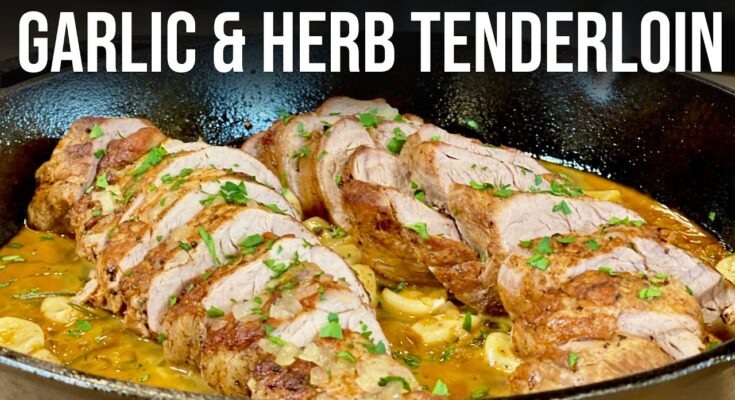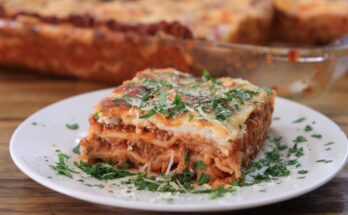Tenderloin Recipe: There’s something almost magical about a perfectly cooked tenderloin. Whether you’re aiming to impress at a dinner party or just craving something indulgent for a weeknight meal, tenderloin is your go-to cut. It’s the filet mignon of the roast world—tender, juicy, and full of rich, meaty flavor. But don’t let its elegance intimidate you. With the right guidance, anyone can master the art of cooking a mouthwatering tenderloin at home.
This guide will walk you through every essential step, from picking the perfect cut at the butcher shop to slicing it at the dinner table. So roll up your sleeves and get ready for some serious culinary satisfaction.
What Makes Tenderloin Special?
Tenderloin is known for being one of the most tender cuts of beef or pork. Located along the spine, it gets very little exercise, which is why it’s so soft and buttery in texture. It’s lean, but when cooked correctly, it offers a melt-in-your-mouth experience that few other meats can match.
Unlike tougher cuts like brisket or shoulder that need hours of slow cooking, the tenderloin can be cooked relatively quickly while still delivering a juicy and flavorful bite. It’s also versatile—great for roasting, grilling, pan-searing, or even sous vide if you’re feeling fancy.
Its luxurious nature is what makes it a holiday staple or a special-occasion centerpiece. However, with the right technique, it can easily become a star in your regular meal rotation.
Choosing the Right Cut of Tenderloin
When shopping for tenderloin, freshness and quality are everything. You’ll generally find two types at the store: pork tenderloin and beef tenderloin. While the basic cooking techniques are similar, beef tenderloin is richer and more decadent, while pork is lighter and a bit sweeter in flavor.
Here’s what to look for when choosing the right cut:
- Color: Look for a bright red (for beef) or light pink (for pork) hue with minimal discoloration.
- Marbling: While tenderloin is naturally lean, a little marbling (thin veins of fat) adds flavor.
- Size: A whole beef tenderloin can weigh 4–6 pounds, enough to feed a crowd. Pork tenderloins usually weigh 1–1.5 pounds each.
Ask your butcher for a “center-cut” tenderloin if you want a more uniform shape for even cooking. And don’t be shy—have them trim off the silver skin if you’re not comfortable doing it at home.
Ingredients You’ll Need
Now that you’ve picked your perfect cut, it’s time to gather your ingredients. Keeping things simple will allow the natural flavor of the tenderloin to shine, but there’s always room to jazz it up with herbs, spices, and glazes.
Essential Ingredients
You don’t need a mile-long grocery list for a fantastic tenderloin dish. In fact, some of the best versions rely on just a few kitchen staples:
- Tenderloin (beef or pork) – 2–4 pounds depending on how many you’re feeding
- Kosher salt – Enhances the flavor
- Freshly cracked black pepper – Adds a bit of bite
- Olive oil or butter – For searing and adding richness
- Garlic cloves (minced) – Optional, but adds great aroma
- Fresh herbs (like rosemary, thyme, or sage) – Perfect for infusing flavor
These basic ingredients are enough to create a delicious and well-seasoned tenderloin. Remember, when it comes to tenderloin, less is often more.
Optional Add-ons for Flavor Enhancement
If you want to elevate your tenderloin even further, consider these flavorful extras:
- Mustard glaze – Dijon or whole grain mustard works wonderfully
- Balsamic vinegar or red wine reduction – Adds acidity and depth
- Smoked paprika or cayenne pepper – For a kick of spice
- Crushed nuts like pistachio or pecan for crusting – Adds texture and flair
- Breadcrumbs mixed with herbs – A crispy herb crust is always a crowd-pleaser
Feel free to experiment and make the recipe your own. Whether you’re going rustic or elegant, these additions can help you match your tenderloin to any cuisine or theme.
Preparing the Tenderloin
Before it hits the heat, your tenderloin needs a little prep. This step is crucial to ensure a flawless final result, and skipping it could mean uneven cooking or a chewy bite.
Trimming the Meat
If your tenderloin came straight from the butcher untrimmed, you’ll need to remove the silver skin—a shiny, tough membrane that doesn’t break down during cooking. Leaving it on can cause the meat to curl and cook unevenly.
Here’s how to trim it like a pro:
- Place the meat on a cutting board.
- Use a sharp boning knife to carefully slide under the silver skin.
- Gently pull it taut and slice away from the meat with smooth, shallow cuts.
- Trim any large fat deposits, but don’t remove all the fat—it adds flavor!
This process only takes a few minutes but makes a big difference in tenderness and presentation.
Marinating Tips for Flavor Depth
While tenderloin is naturally flavorful, marinating it can help infuse additional taste. A basic marinade should include:
- An acid (like lemon juice, vinegar, or wine)
- Oil (to keep the meat moist)
- Flavor agents (like garlic, soy sauce, herbs, and spices)
Let the meat marinate for 2–12 hours in the fridge, turning occasionally for even absorption. If you’re short on time, even a 30-minute marinade or dry rub can make a noticeable difference.
Pro tip: Don’t over-marinate. Too much acid for too long can actually start to break down the meat, making it mushy.
Cooking Methods Explained
Not all cooking methods are created equal when it comes to tenderloin. Depending on your preferences and kitchen tools, you’ve got several great options.
Oven Roasting
Roasting is a classic and reliable way to prepare tenderloin. It provides even cooking and allows for great internal temperature control.
- Preheat your oven to 400°F (204°C).
- After searing, roast the meat until it hits your desired doneness (more on that later).
- Use a meat thermometer to avoid guesswork.
Roasting works beautifully when paired with a pan sauce or herbed crust.
Pan Searing to Lock In Juices
Pan searing is a powerful cooking technique that gives your tenderloin a flavorful, caramelized crust. If you want that irresistible golden-brown exterior with a juicy interior, this step is non-negotiable.
Here’s how to do it right:
- Heat a cast-iron or heavy skillet over medium-high heat.
- Add a tablespoon of olive oil or butter (or both for richness).
- Once the oil shimmers, place the seasoned tenderloin in the pan.
- Sear for 2–3 minutes per side, turning to brown every surface evenly.
Don’t overcrowd the pan or move the meat too much—let it develop that deep, savory crust. Pan searing not only adds flavor but also creates the perfect texture, sealing in those savory juices before roasting or finishing in the oven.
For a bit more flavor, toss in crushed garlic cloves and fresh herbs while searing. They’ll infuse the oil and the meat with an aromatic punch.
Grilling Techniques for Outdoor Cooks
If you love a smoky, fire-kissed flavor, grilling your tenderloin is a fantastic option—especially during warmer months or for backyard gatherings. It’s quick, flavorful, and adds a beautiful char you just can’t get indoors.
Follow these simple grilling tips:
- Preheat the grill to medium-high (around 400–450°F).
- Brush the grates with oil to prevent sticking.
- Sear the tenderloin over direct heat for 2–3 minutes per side to get that crust.
- Move it to indirect heat and cover the lid, allowing it to cook through slowly.
Keep a meat thermometer handy and monitor closely. Since tenderloin is lean, it can dry out quickly if overcooked. Pull it off the grill a few degrees before your target temp—it’ll continue to cook while resting.
You can even baste it with melted herb butter or a balsamic glaze in the final minutes to take the flavor up a notch.
Step-by-Step Cooking Instructions
With your tenderloin prepped and your cooking method selected, let’s dive into the exact steps that will take you from raw to restaurant-worthy.
Preheating and Seasoning
Start by preheating your oven or grill to ensure even cooking. While it heats, let your meat come to room temperature—this step helps it cook more evenly and retain moisture.
Now for seasoning:
- Generously rub with olive oil to help the spices stick.
- Season liberally with kosher salt and black pepper.
- Add minced garlic, fresh herbs, or your favorite spice mix for extra character.
Massage the seasoning into the meat with your hands to make sure it’s well-distributed. Don’t be shy—this is what builds that rich, savory flavor crust.
Some people like to tie the tenderloin with butcher’s twine to keep its shape uniform during cooking. This ensures it cooks evenly from end to end.
Cooking Times and Temperatures
Precision is key when it comes to tenderloin. Use a meat thermometer for accurate results, and aim for these internal temps based on your preferred doneness:
- Rare: 120–125°F (49–52°C)
- Medium Rare: 130–135°F (54–57°C)
- Medium: 140–145°F (60–63°C)
- Well Done: Not recommended for tenderloin—it loses too much juiciness
General cooking time guidelines:
- Oven roast at 400°F: about 20–25 minutes for medium-rare (for a 2–3 lb tenderloin)
- Grill over indirect heat: 25–30 minutes
- Sous vide: Cook at 130°F for 1.5–2 hours, then finish with a quick sear
Always pull the tenderloin off the heat about 5 degrees before your target temperature. It will continue to cook slightly during the resting phase.
Letting the Tenderloin Rest
This might be the most underrated step of all, but it’s absolutely essential.
After cooking, transfer your tenderloin to a cutting board and loosely tent it with foil. Let it rest for 10–15 minutes. During this time, the juices redistribute throughout the meat, resulting in a moist, tender, and flavorful roast.
If you cut into it too soon, all that flavorful juice will spill out, leaving your meat dry. Be patient—it’s worth the wait.
Use this resting time to whip up a pan sauce with the fond (brown bits left in the pan), butter, garlic, and a splash of wine or broth. Drizzle it over the sliced tenderloin for an extra gourmet touch.
Slicing and Serving the Tenderloin
So, your tenderloin has rested to perfection. Now it’s time to slice and serve it up in all its juicy glory. But hold up—there’s an art to slicing that can make or break the presentation and texture.
Here’s how to do it like a pro:
- Use a sharp carving knife or chef’s knife. A dull blade will tear the meat instead of cutting cleanly.
- Slice against the grain. This shortens the muscle fibers, making each bite more tender.
- Cut into ½ to 1-inch thick slices, depending on preference. Thicker slices retain more moisture.
Want to step it up? Plate it with style:
- Fan the slices out slightly on a platter.
- Spoon any resting juices or pan sauce over the top.
- Garnish with fresh herbs or a sprinkle of flaky sea salt.
Pair with complementary sides like roasted vegetables, creamy mashed potatoes, or a fresh green salad for a complete meal. Whether it’s a date night or a family dinner, this plating style makes it feel restaurant-worthy.
Serving Ideas for Different Occasions
Tenderloin is a chameleon—it fits in at both black-tie dinners and casual backyard cookouts. Here are a few serving ideas based on the vibe:
- Holiday Feast: Serve alongside garlic mashed potatoes, green beans almondine, and a rich red wine jus.
- Summer BBQ: Pair with grilled corn, potato salad, and a tangy chimichurri sauce.
- Elegant Dinner Party: Add a wild mushroom risotto, arugula salad, and a bold Cabernet Sauvignon.
- Quick Weeknight Dinner: Keep it simple with roasted sweet potatoes and sautéed spinach.
For a crowd, consider turning the tenderloin into sliders or tacos. Thin slices on mini buns with aioli and arugula are always a hit.
Storing and Reheating Leftovers
Let’s be honest—if you’ve cooked your tenderloin right, leftovers might be rare. But if you do have some extra, storing and reheating it properly ensures it stays just as juicy the next day.
How to Store Tenderloin
- Let it cool to room temperature before storing.
- Wrap tightly in foil or place in an airtight container.
- Store in the refrigerator for up to 4 days.
- For longer storage, slice and freeze in portions for up to 3 months.
Make sure to label your container with the date—trust me, you’ll thank yourself later.
Reheating Without Drying Out
Reheating tenderloin is tricky—do it wrong, and you’ll end up with a dry mess. Here’s the best method:
- Preheat your oven to 250°F (120°C).
- Place slices in a baking dish and cover with foil.
- Add a splash of broth or water to help retain moisture.
- Heat gently for about 10–15 minutes until warmed through.
Avoid the microwave if possible. It tends to zap the moisture right out. But if you must, do it in short bursts and cover the meat with a damp paper towel.
Want to reuse leftovers creatively? Chop them up for steak tacos, tenderloin stir-fry, or even add to a hearty pasta dish.
Common Mistakes to Avoid
Even the best cuts of meat can go wrong if you’re not careful. Avoid these tenderloin blunders:
1. Skipping the Thermometer
Guessing the doneness is a risky game. Always use an instant-read meat thermometer. It’s your best friend for nailing the perfect cook.
2. Overcooking the Meat
Tenderloin is lean, so overcooking dries it out fast. Pull it off the heat just before your target temp and let it finish cooking while it rests.
3. Not Letting It Rest
This is a huge mistake. Cutting too soon causes all the juices to spill out, leaving you with dry slices. Give it at least 10–15 minutes under foil.
4. Forgetting to Season Generously
Don’t be shy with salt and pepper. It’s what builds that flavorful crust. Also, season every side for even coverage.
5. Using Low-Quality Meat
Cheap or poorly butchered tenderloin won’t deliver the same tenderness or flavor. Always buy from a trusted source, and opt for grass-fed or organic if possible.
Avoiding these common slip-ups ensures your tenderloin turns out flawless every time.
Tips for Elevating Your Tenderloin Game
Want to turn your already-amazing tenderloin into a dish your guests won’t stop talking about? Here are a few next-level pro tips:
1. Use Compound Butter
Top your freshly sliced tenderloin with a pat of compound butter. Try mixing softened butter with garlic, parsley, chives, and lemon zest. It melts into the meat, adding richness and flavor.
2. Try a Reverse Sear
Instead of searing first, slow-roast the tenderloin at 225°F until it’s about 10 degrees under your target temp. Then finish with a blazing hot sear in a skillet. This method gives you a perfectly even cook with a beautiful crust.
3. Experiment with Rubs and Crusts
Instead of basic salt and pepper, try spice rubs—coffee and chili powder, herbes de Provence, or mustard seed and garlic powder. Or coat the tenderloin in Dijon mustard and crushed nuts for a sophisticated texture.
4. Infuse with Aromatics
When roasting, tuck garlic cloves, rosemary sprigs, or shallots under the tenderloin. These aromatics perfume the meat and make your kitchen smell like heaven.
5. Rest with Purpose
While resting the meat, place a few pats of herb butter on top so they melt in, adding flavor and keeping the meat moist.
By incorporating even a few of these tips, you’ll elevate your tenderloin from great to unforgettable.
FAQs about Tenderloin Recipe
1. What is the best way to cook tenderloin?
The best way to cook tenderloin is by first searing it on high heat to lock in the juices, then finishing it in the oven at a lower temperature for even cooking. This method ensures a juicy and tender result.
2. Should I marinate tenderloin before cooking?
Yes, marinating tenderloin for a few hours—or overnight—can enhance its flavor. Choose a marinade with acidic ingredients like vinegar or lemon juice to tenderize the meat.
3. How do I know when tenderloin is done?
Use a meat thermometer for accuracy. Tenderloin is perfectly cooked when the internal temperature reaches 135°F (57°C) for medium-rare or 145°F (63°C) for medium.
4. Can I grill tenderloin?
Absolutely! Grilling adds a smoky flavor. Sear over direct heat, then move it to indirect heat to finish cooking slowly and evenly.
5. How long should I rest the tenderloin before slicing?
Let your tenderloin rest for 5–10 minutes after cooking. This allows the juices to redistribute, keeping the meat moist and flavorful.
Conclusion
Cooking the perfect tenderloin isn’t reserved for top chefs—it’s totally achievable in your own kitchen. With a high-quality cut, the right prep, and a little patience, you can deliver a mouthwatering main course that impresses every time.
From choosing the right meat and mastering the marinade to nailing the sear and slicing it just right, this guide has everything you need to get it done like a pro. Follow the steps, trust your thermometer, and don’t forget to let it rest.
So next time you’re planning a celebration—or just craving something next-level—you know exactly what to cook. Go on, give this tenderloin recipe a try. Your taste buds (and your dinner guests) will thank you.



